Urban Flooding Disaster Risk Assessment Utilizing the MaxEnt Model and Game Theory: A Case Study of Changchun, China
Abstract
:1. Introduction
2. Materials and Methods
2.1. Study Area
2.2. Index Selection and Data Collection
2.3. Research Methods
2.3.1. The MaxEnt Model
2.3.2. The Analytic Hierarchy Process (AHP)
2.3.3. Principal Component Analysis (PCA)
- (1)
- Determining the coefficients of the indicators in linear combinations of principal components. Suppose there is an existing set of data with n indicators and m objects to be evaluated. The first principal components and their corresponding eigenvalues and eigenvectors can be obtained using principal component analysis. Then, the coefficients of the corresponding indicators in each principal component areα is the eigenvalue associated with each principal component; and is the element corresponding to each indicator in each principal component.
- (2)
- The contribution to the variance of the eigenvalues of the first principal components is , and the model coefficient of the composite score is ( corresponds to the composite coefficient of each indicator); then,The composite score model is obtained as
- (3)
- We normalize the indicator weights:
2.3.4. Game Theory Portfolio Weighting
2.3.5. Integrated Natural Disaster Risk Management Theory
2.3.6. Methods for Analyzing Spatial Autocorrelation
3. Results
3.1. Urban Flood Risk Assessment Using the MaxEnt Model
3.2. Analysis of the Results of Integrated Natural Disaster Risk Management Theory
3.2.1. Game Theory Portfolio Weights
3.2.2. Hazard Analysis
3.2.3. Exposure Analysis
3.2.4. Vulnerability Analysis
3.2.5. Emergency Response and Recovery Capability Analysis (ERC)
3.2.6. Changchun Urban Flooding Risk Assessment
3.3. Verification Analysis
3.4. Analysis of Spatial Autocorrelation
3.4.1. Analysis of Global Spatial Autocorrelation
3.4.2. Analysis of Local Spatial Autocorrelation
4. Discussion
5. Conclusions
Author Contributions
Funding
Institutional Review Board Statement
Informed Consent Statement
Data Availability Statement
Conflicts of Interest
References
- Jia, C.; Guo, H.; Wen, C. Towards better flood risk management: Assessing flood risk and investigating the potential mechanism based on machine learning models. J. Environ. Manag. 2021, 293, 112810. [Google Scholar]
- Lin, J.; He, X.; Lu, S.; Liu, D.; He, P. Investigating the influence of three-dimensional building configuration on urban pluvial flooding using random forest algorithm. Environ. Res. 2020, 196, 110438. [Google Scholar] [CrossRef]
- Zhou, S.; Zhang, D.; Wang, M.; Liu, Z.; Gan, W.; Zhao, Z.; Xue, S.; Müller, B.; Zhou, M.; Ni, X.; et al. Risk-driven composition decoupling analysis for urban flooding prediction in high-density urban areas using Bayesian-Optimized LightGBM. J. Clean. Prod. 2024, 457, 142286. [Google Scholar] [CrossRef]
- Yang, J.; Duan, C.; Wang, H.; Chen, B. Spatial supply-demand balance of green space in the context of urban waterlogging hazards and population agglomeration. Resour. Conserv. Recycl. 2023, 188, 106662. [Google Scholar] [CrossRef]
- Zang, D.; Yan, D.; Wang, Y.; Lu, C. Research Progress on Risk Assessment and Integrated Strategies for Urban Pluvial Flooding. J. Catastrophol. 2014, 29, 144–149. [Google Scholar]
- Benito, G.; Lang, M.; Barriendos, M.; Llasat, M.C.; Francés, F.; Ouarda, T.; Thorndycraft, V.; Enzel, Y.; Bardossy, A.; Coeur, D.; et al. Use of systematic, palaeoflood and historical data for the improvement of flood risk estimation. Review of scientific methods. Nat. Hazards 2004, 31, 623–643. [Google Scholar]
- Yin, S.; Wang, H.; Wang, D.; Huang, C. Historical flood disasters and climate change in the upper reaches of Hanjiang River in southern Shaanxi Province. Arid Land Res. 2010, 27, 522–528. [Google Scholar]
- Luino, F.; Barriendos, M.; Gizzi, F.T.; Glaser, R.; Gruetzner, C.; Palmieri, W.; Turconi, L. Historical Data for Natural Hazard Risk Mitigation and Land Use Planning. Land 2023, 12, 1777. [Google Scholar] [CrossRef]
- Zhu, D.; Zhi, X.; Sein, Z.M.M.; Ji, Y.; Tian, X.; Pan, M. Possible Relationships between the Interdecadal Anomalies of Heavy Rainfall under Northeastern China Cold Vortexes and the Sea Surface Temperature (SST). Atmosphere 2022, 13, 354. [Google Scholar] [CrossRef]
- Jing, X.; Fan, J.; Zhang, J.; Tong, Z.; Liu, X. Risk assessment of rainstorm and flood disaster in Songhua River main stream based on GIS. J. Catastrophol. 2009, 24, 51–56. [Google Scholar]
- Bhatt, G.D.; Sinha, K.; Deka, P.K.; Kumar, A. Flood Hazard and Risk Assessment in Chamoli District, Uttarakhand Using Satellite Remote Sensing and GIS Techniques. Int. J. Innov. Res. Sci. Eng. Technol. 2014, 3, 15348–15356. [Google Scholar] [CrossRef]
- Huang, G.; Luo, H.; Chen, W.; Pan, J. Urban flood disaster scenario simulation and risk assessment in Donghaoyong Basin, Guangzhou. Adv. Water Sci. 2019, 30, 643–652. [Google Scholar]
- Zhao, L.; Zhang, T.; Li, J.; Zhang, L.; Feng, P. Numerical simulation study of urban hydrological effects under low impact development with a physical experimental basis. J. Hydrol. 2023, 618, 129191. [Google Scholar] [CrossRef]
- Zhu, X.; Chen, Z.; Zhong, L. The risk pre-estimation of the flood casualty loss caused by heavy rainstorm in Jilin Province. J. Glaciol. Geocryol. 2016, 38, 395–401. [Google Scholar]
- Zhang, D.; Shi, X.; Xu, H.; Jing, Q.; Pan, X.; Liu, T.; Wang, H.; Hou, H. A GIS-based spatial multi-index model for flood risk assessment in the Yangtze River Basin, China. Environ. Impact Assess. Rev. 2020, 83, 106397. [Google Scholar] [CrossRef]
- Wang, C.; Wang, K.; Liu, D.; Zhang, L.; Li, M.; Khan, M.I.; Li, T.; Cui, S. Development and application of a comprehensive assessment method of regional flood disaster risk based on a refined random forest model using beluga whale optimization. J. Hydrol. 2024, 633, 130963. [Google Scholar] [CrossRef]
- Gao, J.; Murao, O.; Pei, X.; Dong, Y. Identifying Evacuation Needs and Resources Based on Volunteered Geographic Information: A Case of the Rainstorm in July 2021, Zhengzhou, China. Int. J. Environ. Res. Public Health 2022, 19, 16051. [Google Scholar] [CrossRef]
- Zhang, F.; Tan, L.; Zhao, Q.; Wu, Y.; Xu, Y.; Gao, C. Research on urban waterlogging disaster based on hydrodynamic model: A case study of Baihe Community in Ningbo City. J. Nat. Disasters 2021, 30, 209–218. [Google Scholar] [CrossRef]
- Zhang, J.; Li, X.; Zhang, H. Research on urban waterlogging risk prediction based on the coupling of the BP neural network and SWMM model. J. Water Clim. Chang. 2023, 14, 3417–3434. [Google Scholar] [CrossRef]
- Li, J.; Liu, J.; Wu, T.; Peng, Q.; Cai, C. Risk analysis of waterlogging in a big city based on a bow-tie Bayesian network model, using the megacity of Wuhan as an example. Front. Environ. Sci. 2023, 11, 1258544. [Google Scholar] [CrossRef]
- Chen, J.; Li, Y.; Zhang, S. Fast Prediction of Urban Flooding Water Depth Based on CNN−LSTM. Water 2023, 15, 1397. [Google Scholar] [CrossRef]
- Phillips, S.J.; Dudík, M. Modeling of species distributions with Maxent: New extensions and a comprehensive evaluation. Ecography 2008, 31, 161–175. [Google Scholar] [CrossRef]
- Pourghasemi, H.R.; Pouyan, S.; Bordbar, M.; Golkar, F.; Clague, J.J. Flood, landslides, forest fire, and earthquake susceptibility maps using machine learning techniques and their combination. Nat. Hazards 2023, 116, 3797–3816. [Google Scholar] [CrossRef]
- Lin, J.; He, P.; Yang, L.; He, X.; Lu, S.; Liu, D. Predicting future urban waterlogging-prone areas by coupling the maximum entropy and FLUS model. Sustain. Cities Soc. 2022, 80, 103812. [Google Scholar] [CrossRef]
- Zhang, J.-Q.; Liang, J.-D.; Liu, X.-P.; Tong, Z.-J. GIS-Based Risk Assessment of Ecological Disasters in Jilin Province, Northeast China. Hum. Ecol. Risk Assess. Int. J. 2009, 15, 727–745. [Google Scholar] [CrossRef]
- Dong, Y.; Ren, Z.; Fu, Y.; Miao, Z.; He, X. Recording Urban Land Dynamic and Its Effects during 2000–2019 at 15-m Resolution by Cloud Computing with Landsat Series. Remote Sens. 2020, 12, 2451. [Google Scholar] [CrossRef]
- Huang, X.; Li, H.; Zhang, Y.; Yang, X.; Chen, S. Construction of urban waterlogging vulnerability assessment system and vulnerability assessment based on PSR and AHP methods in Xi’an. J. Nat. Disasters 2019, 28, 167–175. [Google Scholar]
- Bertilsson, L.; Wiklund, K.; de Moura Tebaldi, I.; Rezende, O.M.; Veról, A.P.; Miguez, M.G. Urban flood resilience—A multi-criteria index to integrate flood resilience into urban planning. J. Hydrol. 2019, 573, 970–982. [Google Scholar] [CrossRef]
- Dong, Q.; Cooper, O. An orders-of-magnitude AHP supply chain risk assessment framework. Int. J. Prod. Econ. 2016, 182, 144–156. [Google Scholar] [CrossRef]
- Rahman, M.A.T.; Hoque, S.; Saadat, A.H.M. Selection of minimum indicators of hydrologic alteration of the Gorai river, Bangladesh using principal component analysis. Sustain. Water Resour. Manag. 2017, 3, 13–23. [Google Scholar] [CrossRef]
- Liu, B.; Huang, J.J.; McBean, E.; Li, Y. Risk assessment of hybrid rain harvesting system and other small drinking water supply systems by game theory and fuzzy logic modeling. Sci. Total Environ. 2020, 708, 134436. [Google Scholar] [CrossRef]
- Zhang, X.L. The analysis models of exploratory spatial data. Contemp. Econ. Manag. 2007, 29, 26–29. [Google Scholar]
- Moran, P.A. Notes on continuous stochastic phenomena. Biometrika 1950, 37, 17–23. [Google Scholar] [CrossRef]
- Yoshimura, N.; Hiura, T. Demand and supply of cultural ecosystem services: Use of geotagged photos to map the aesthetic value of landscapes in Hokkaido. Ecosyst. Serv. 2017, 24, 68–78. [Google Scholar] [CrossRef]
- Cao, Q.; Gao, Q.-B.; Guo, W.-J.; Zhang, Y.; Wang, Z.-H.; Ma, X.-L.; Zhang, F.-Q.; Chen, S.-L. Impacts of human activities and environmental factors on potential distribution of Swertia przewalskii Pissjauk., an endemic plant in Qing-Tibetan Plateau, using MaxEnt. Plant Sci. J. 2021, 39, 22–31. [Google Scholar]
- Jongman, B. Effective adaptation to rising flood risk. Nat. Commun. 2018, 9, 1986. [Google Scholar] [CrossRef]
- Sar, N.; Chatterjee, S.; Das Adhikari, M. Integrated remote sensing and GIS based spatial modelling through analytical hierarchy process (AHP) for water logging hazard, vulnerability and risk assessment in Keleghai river basin, India. Model. Earth Syst. Environ. 2015, 1, 31. [Google Scholar] [CrossRef]
- Shrestha, R.; Di, L.; Yu, E.G.; Kang, L.; Shao, Y.-Z.; Bai, Y.-Q. Regression model to estimate flood impact on corn yield using MODIS NDVI and USDA cropland data layer. J. Integr. Agric. 2017, 16, 398–407. [Google Scholar] [CrossRef]
- Tayyab, M.; Zhang, J.; Hussain, M.; Ullah, S.; Liu, X.; Khan, S.N.; Baig, M.A.; Hassan, W.; Al-Shaibah, B. Gis-based urban flood resilience assessment using urban flood resilience model: A case study of peshawar city, khyber pakhtunkhwa, pakistan. Remote Sens. 2021, 13, 1864. [Google Scholar] [CrossRef]
- Omran, E.-S.E. Evolving waterlogged identification system to assess spatiotemporal impact of the new Suez Canal corridor, Egypt. J. Coast. Conserv. 2017, 21, 849–865. [Google Scholar] [CrossRef]
- Ha-Mim, N.M.; Rahman, M.A.; Hossain, M.Z.; Fariha, J.N.; Rahaman, K.R. Employing multi-criteria decision analysis and geospatial techniques to assess flood risks: A study of Barguna district in Bangladesh. Int. J. Disaster Risk Reduct. 2022, 77, 103081. [Google Scholar] [CrossRef]
- Szwagrzyk, M.; Kaim, D.; Price, B.; Wypych, A.; Grabska, E.; Kozak, J. Impact of forecasted land use changes on flood risk in the Polish Carpathians. Nat. Hazards 2018, 94, 227–240. [Google Scholar] [CrossRef]
- Hu, S.; Cheng, X.; Zhou, D.; Zhang, H. GIS-based flood risk assessment in suburban areas: A case study of the Fangshan District, Beijing. Nat. Hazards 2017, 87, 1525–1543. [Google Scholar] [CrossRef]
- De Risi, R.; Jalayer, F.; De Paola, F.; Lindley, S. Delineation of flooding risk hotspots based on digital elevation model, calculated and historical flooding extents: The case of Ouagadougou. Stoch. Environ. Res. Risk Assess. 2017, 32, 1545–1559. [Google Scholar] [CrossRef]
- Balica, S.F.; Wright, N.G.; van der Meulen, F. A flood vulnerability index for coastal cities and its use in assessing climate change impacts. Nat. Hazards 2012, 64, 73–105. [Google Scholar] [CrossRef]
- Tran, D.; Xu, D.; Dang, V.; Alwah, A.A.Q. Predicting Urban Waterlogging Risks by Regression Models and Internet Open-Data Sources. Water 2020, 12, 879. [Google Scholar] [CrossRef]
- Shah, A.A.; Ye, J.; Abid, M.; Khan, J.; Amir, S.M. Flood hazards: Household vulnerability and resilience in disaster-prone districts of Khyber Pakhtunkhwa province, Pakistan. Nat. Hazards 2018, 93, 147–165. [Google Scholar] [CrossRef]
- Anselin, L.; Syabri, I.; Kho, Y. Geoda: An introduction to spatial data analysis. Geogr. Anal. 2005, 38, 5–22. [Google Scholar] [CrossRef]

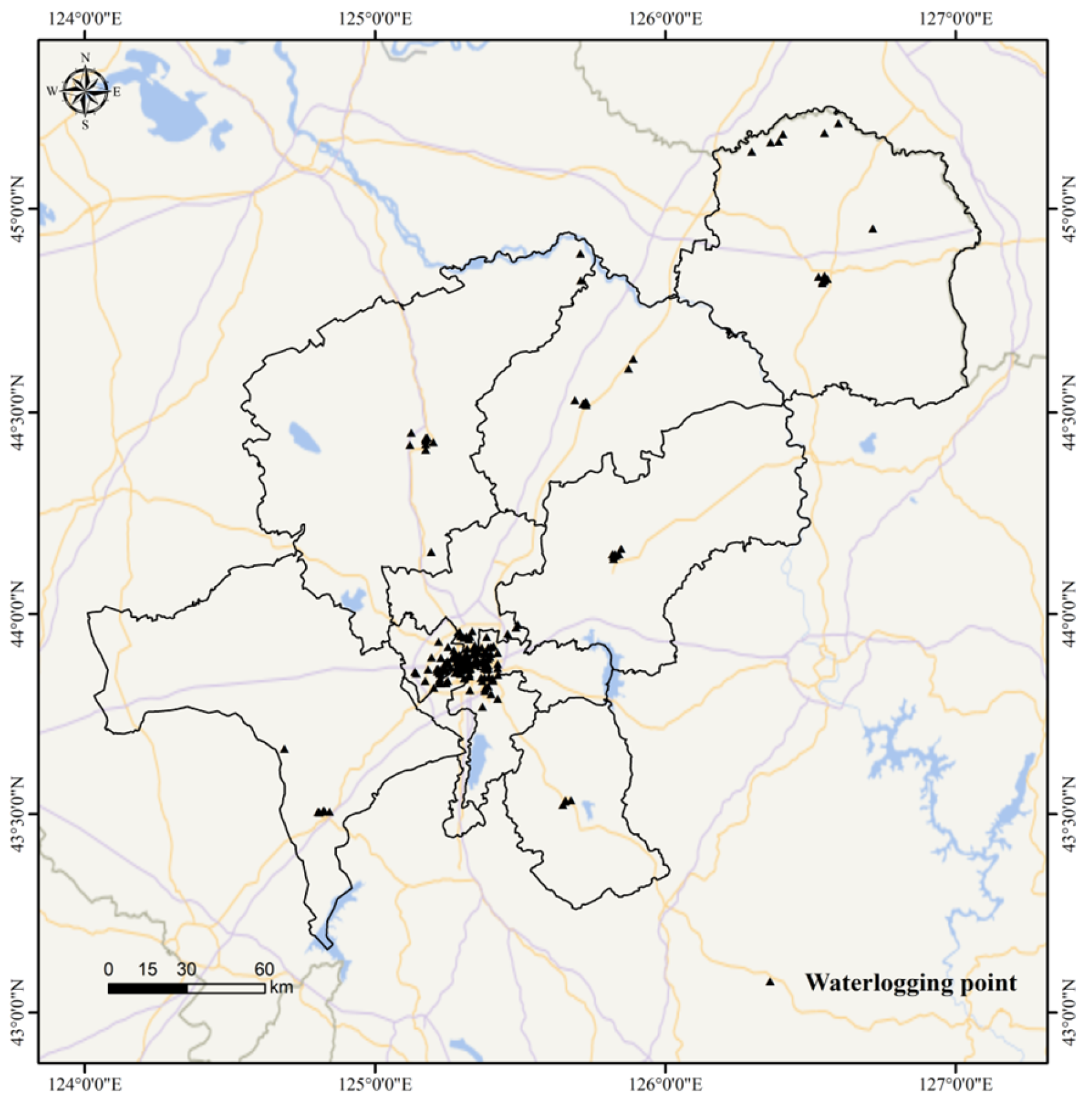
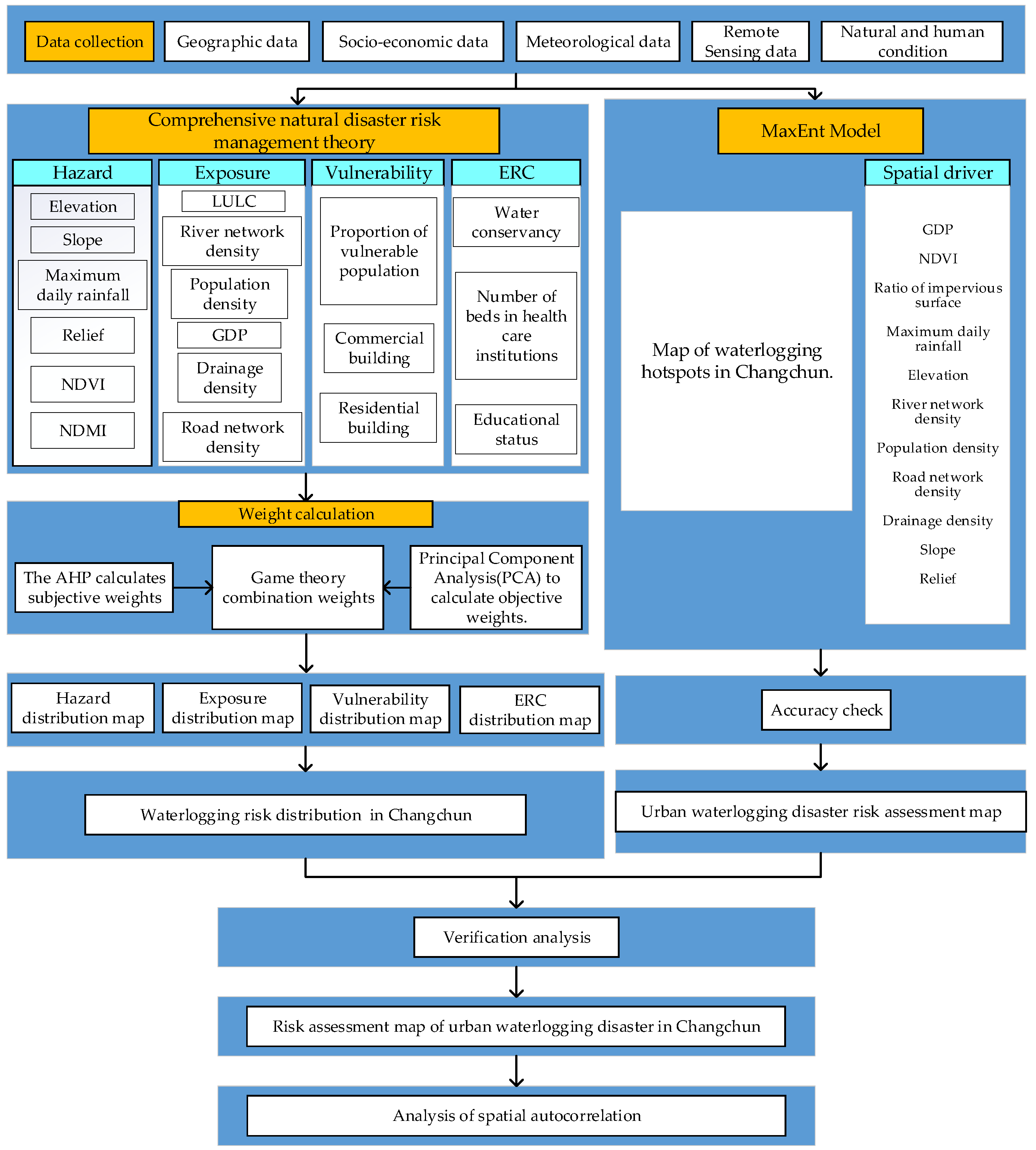
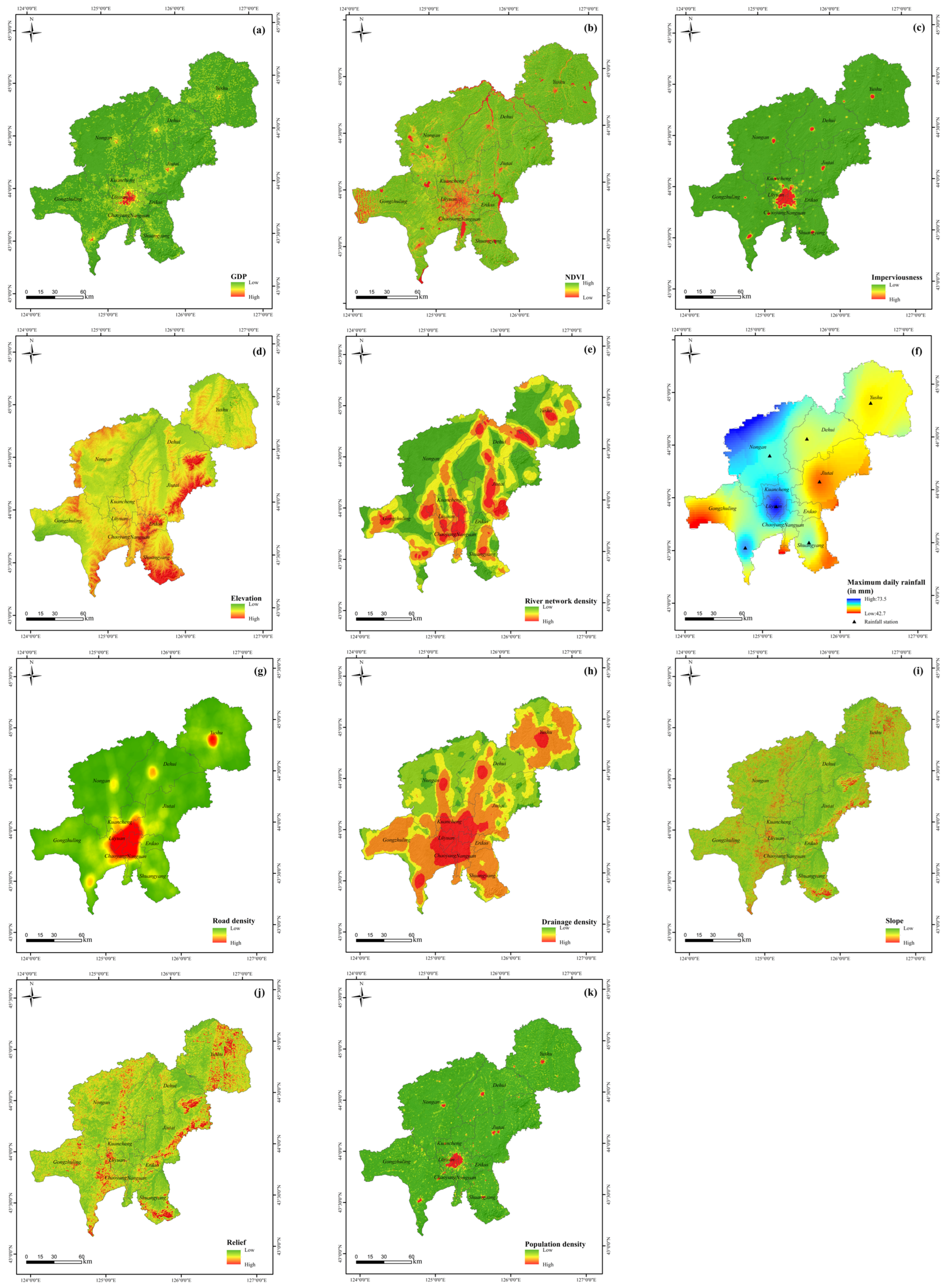
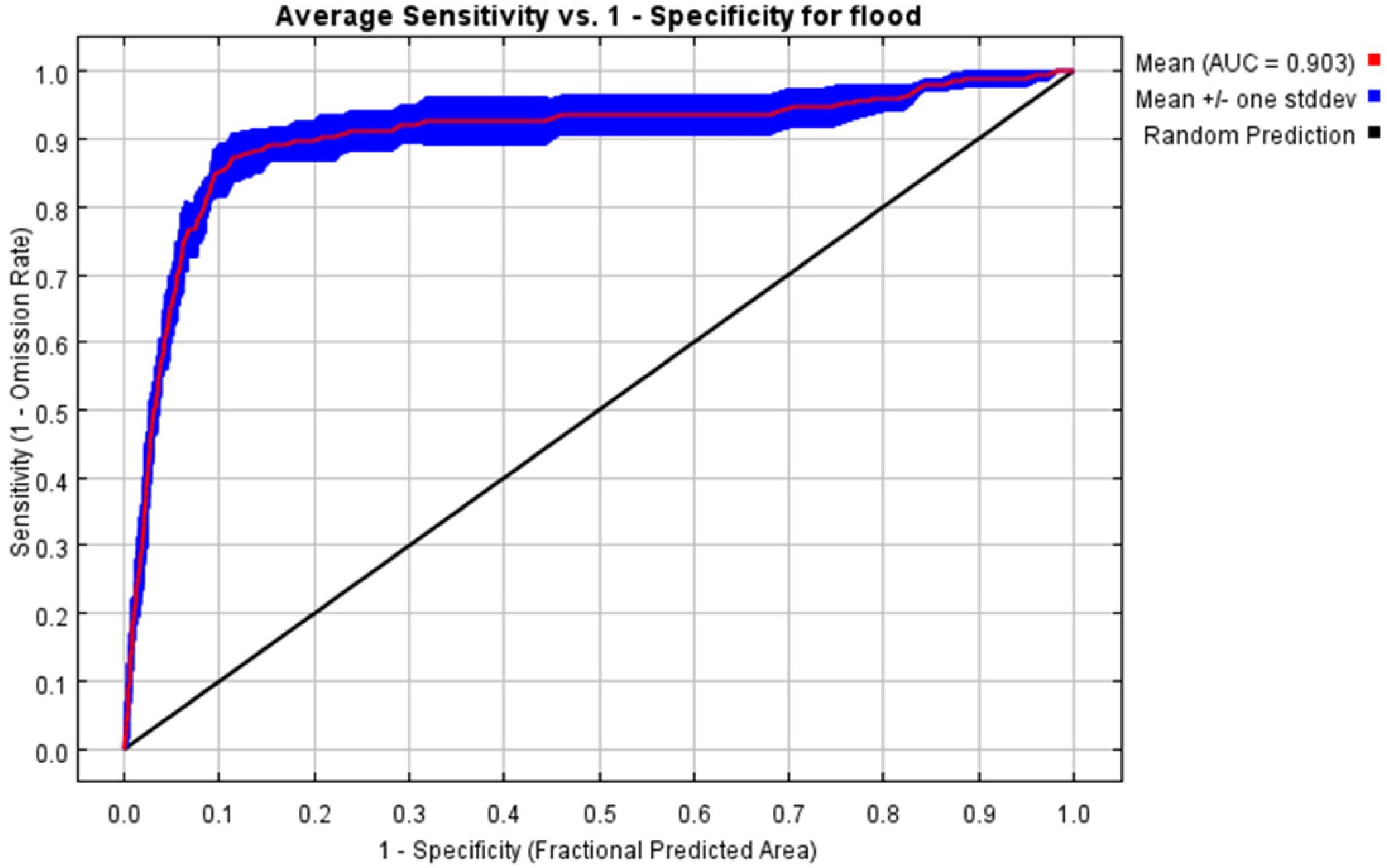
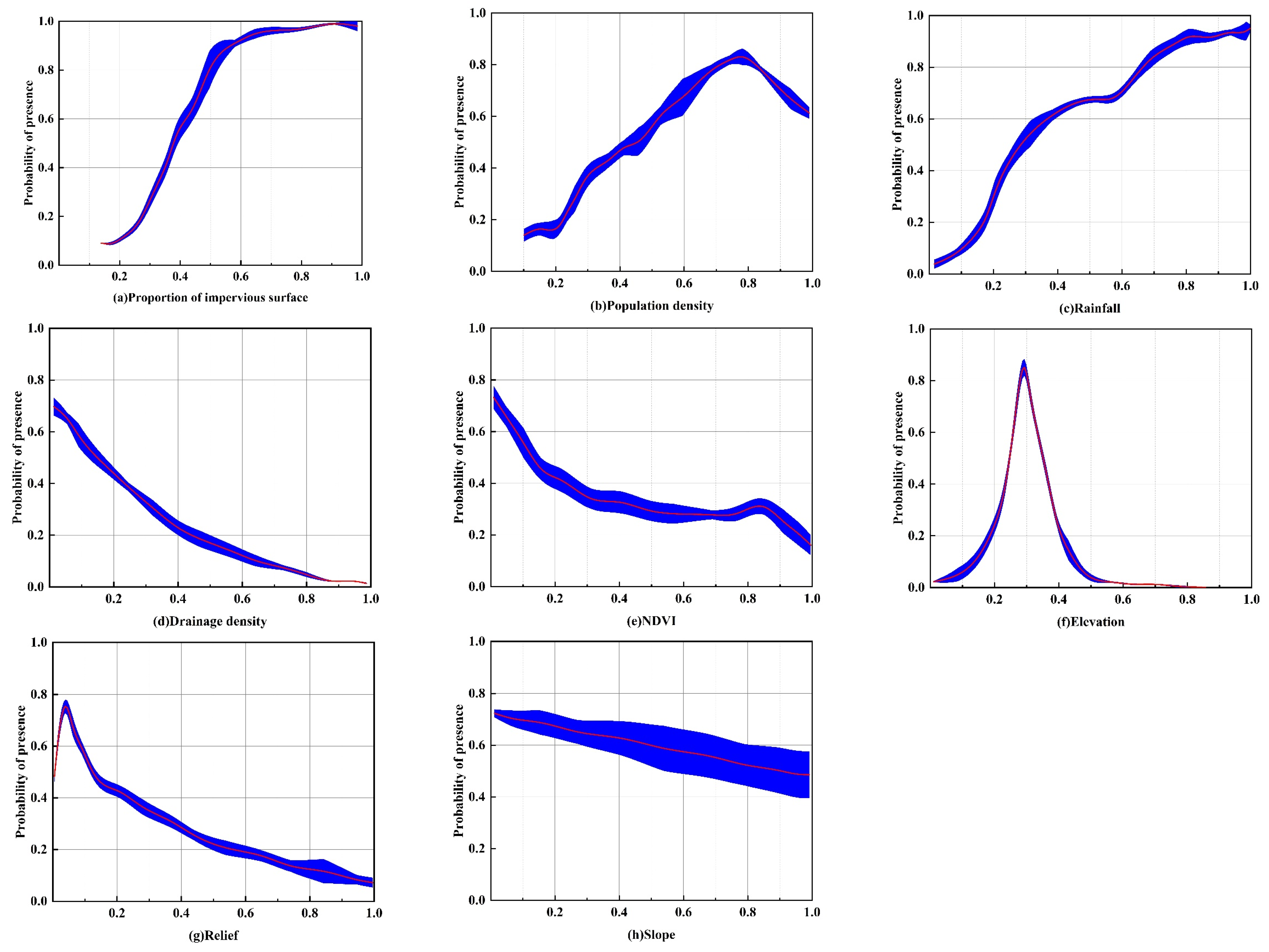


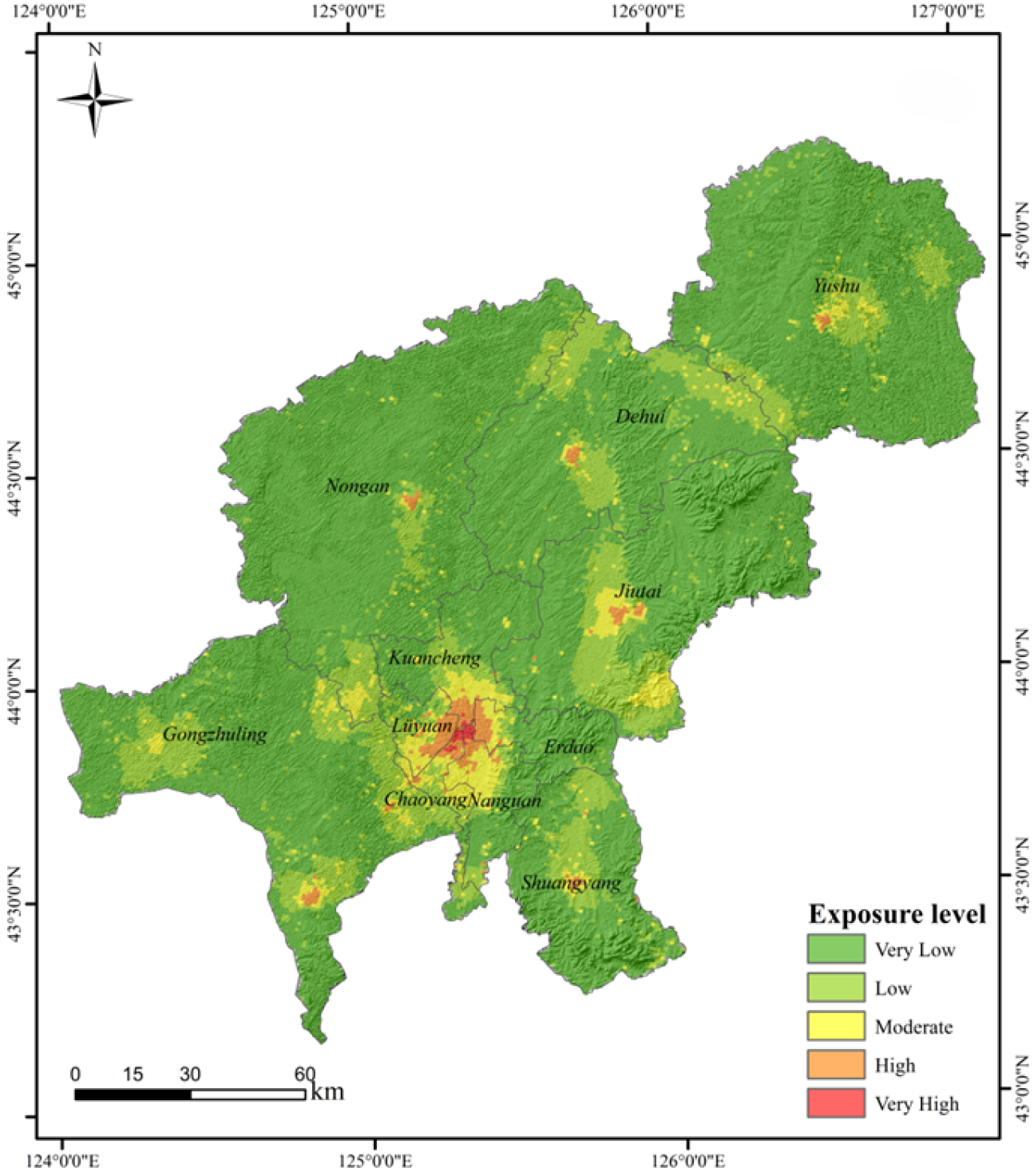
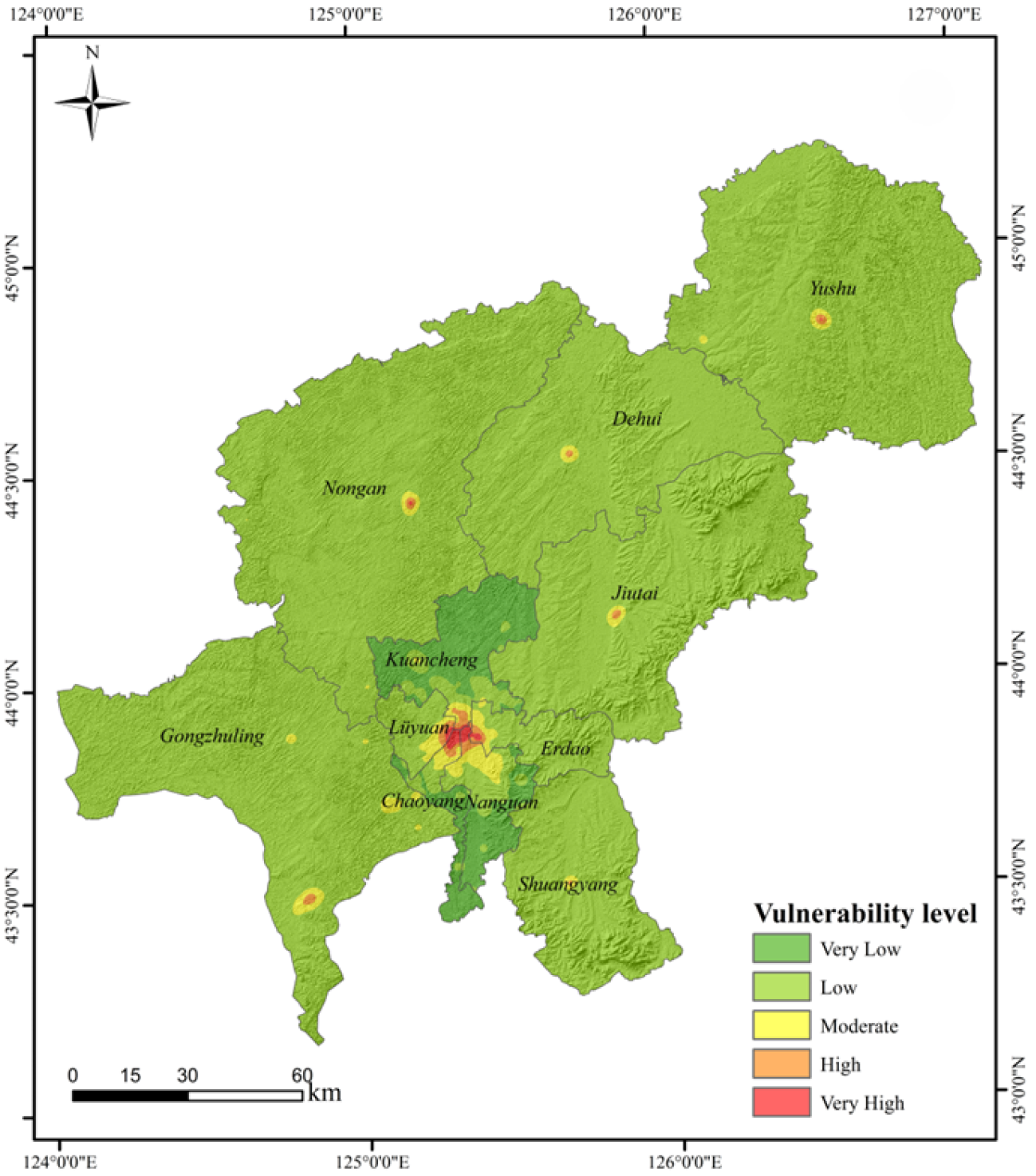


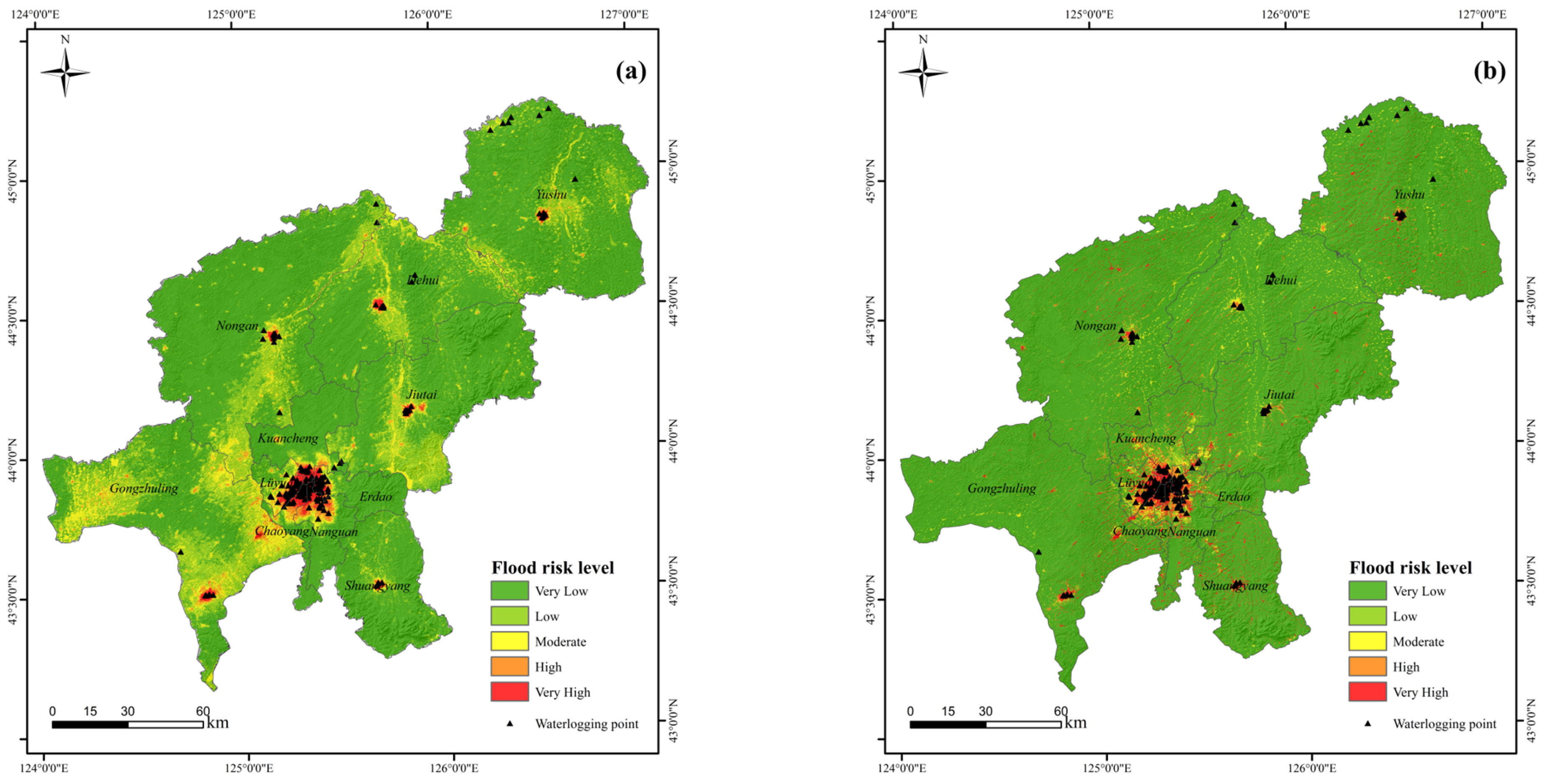



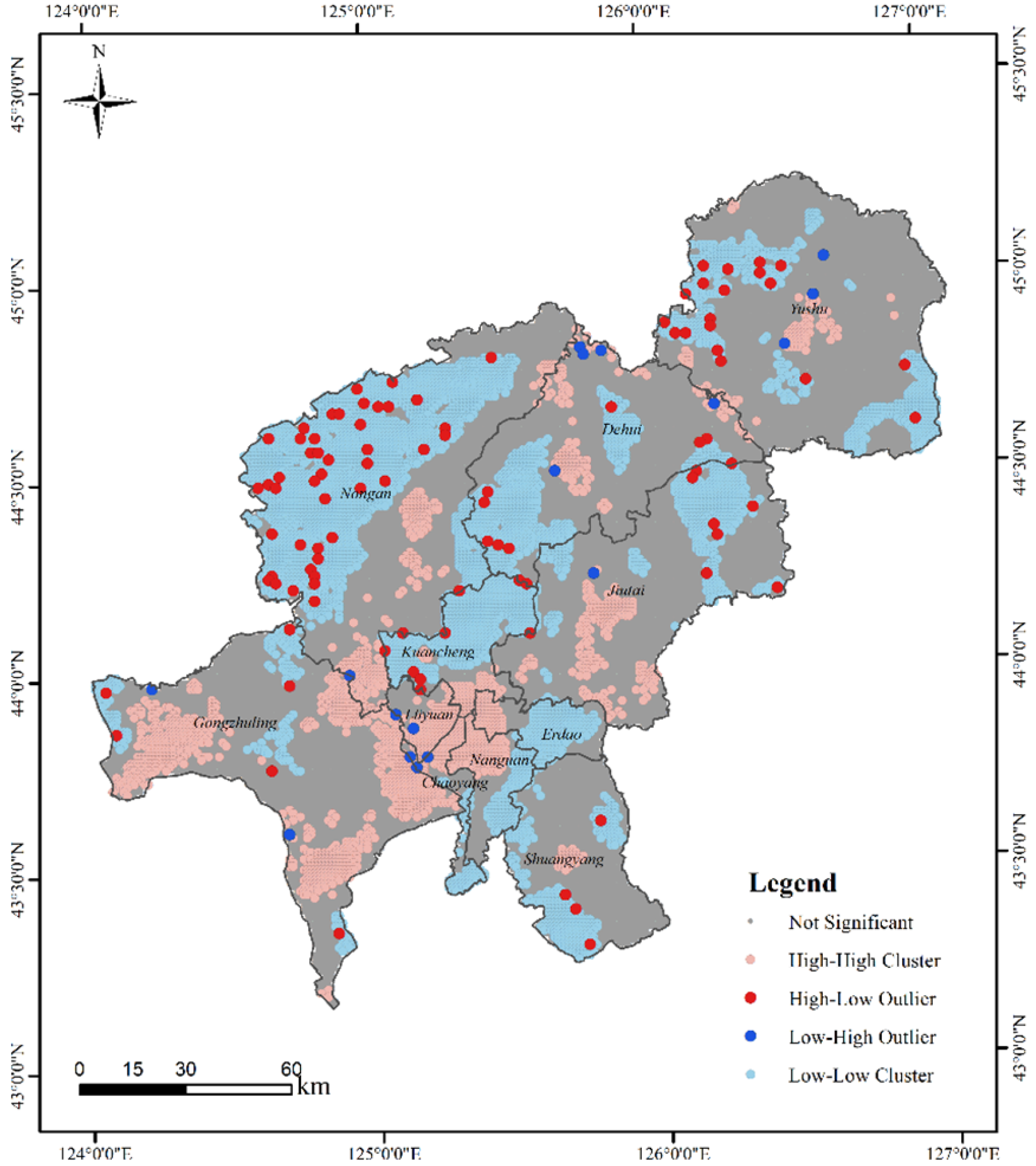
| Index | Data Type | Data Details | Data Source |
|---|---|---|---|
| Elevation | Raster data | 2023 | Geospatial data clouds |
| Slope | Raster data | 2023 | Geospatial data clouds |
| Maximum daily rainfall | Raster data | 2020 | Jilin Meteorological Service |
| Relief | Raster data | 2023 | Geospatial data clouds |
| NDMI | Landsat 8 OLI_TIRS | 2023 | Geospatial data clouds |
| NDVI | Landsat 8 OLI_TIRS | 2023 | Geospatial data clouds |
| LULC | Raster data | 2022 | https://www.databox.store (accessed on 15 November 2023) |
| River network density | Raster data | 2023 | National Data Center for Meteorological Sciences |
| Population density | Raster data | 2023 | World UN population density dataset |
| Road network density | Road network Shape file | 2023 | Geospatial data clouds |
| GDP | Raster data | 2022 | National Bureau of Statistics |
| Drainage density | Raster data | 2023 | https://www.databox.store (accessed on 15 November 2023) |
| Percentage of the vulnerable population | Attribute data | 2022 | Changchun Statistical Yearbook |
| Commercial buildings | POI | 2023 | http://www.guihuayun.com (accessed on 23 October 2023) |
| Residential buildings | POI | 2023 | http://www.guihuayun.com (accessed on 23 October 2023) |
| Water conservancy | Attribute data | 2022 | Changchun Statistical Yearbook |
| Number of beds in health care institutions | Attribute data | 2022 | Changchun Statistical Yearbook |
| Educational status | Attribute data | 2022 | Changchun Statistical Yearbook |
| Proportion of Impervious Surfaces | Population Density | Drainage Density | Maximum Daily Rainfall | NDVI | Elevation | Relief | Slope | Road Network Density | River Network Density | GDP |
|---|---|---|---|---|---|---|---|---|---|---|
| 20.6 | 18.1 | 13.1 | 9.6 | 8.5 | 7.4 | 6.6 | 5.3 | 4.8 | 3.3 | 2.7 |
| Criterion Layer | Criterion Layer Weight | Index Level | Index Layer Weight |
|---|---|---|---|
| Hazard index | 0.4054 | Elevation | 0.2028 |
| Slope | 0.1748 | ||
| Maximum daily rainfall | 0.2381 | ||
| Relief | 0.1672 | ||
| NDMI | 0.1024 | ||
| NDVI | 0.1147 | ||
| Exposure index | 0.2041 | LULC | 0.2749 |
| River network density | 0.0950 | ||
| Population density | 0.1610 | ||
| Road network density | 0.0641 | ||
| GDP | 0.2060 | ||
| Drainage density | 0.1990 | ||
| Vulnerability index | 0.1567 | Proportion of the vulnerable population | 0.2200 |
| Commercial buildings | 0.4800 | ||
| Residential buildings | 0.3000 | ||
| Emergency response and recovery capacity index | 0.2337 | Water conservancy | 0.4056 |
| Number of beds in health care institutions | 0.2472 | ||
| Educational status | 0.3472 |
Disclaimer/Publisher’s Note: The statements, opinions and data contained in all publications are solely those of the individual author(s) and contributor(s) and not of MDPI and/or the editor(s). MDPI and/or the editor(s) disclaim responsibility for any injury to people or property resulting from any ideas, methods, instructions or products referred to in the content. |
© 2024 by the authors. Licensee MDPI, Basel, Switzerland. This article is an open access article distributed under the terms and conditions of the Creative Commons Attribution (CC BY) license (https://creativecommons.org/licenses/by/4.0/).
Share and Cite
Huang, F.; Zhu, D.; Zhang, Y.; Zhang, J.; Wang, N.; Dong, Z. Urban Flooding Disaster Risk Assessment Utilizing the MaxEnt Model and Game Theory: A Case Study of Changchun, China. Sustainability 2024, 16, 8696. https://doi.org/10.3390/su16198696
Huang F, Zhu D, Zhang Y, Zhang J, Wang N, Dong Z. Urban Flooding Disaster Risk Assessment Utilizing the MaxEnt Model and Game Theory: A Case Study of Changchun, China. Sustainability. 2024; 16(19):8696. https://doi.org/10.3390/su16198696
Chicago/Turabian StyleHuang, Fanfan, Dan Zhu, Yichen Zhang, Jiquan Zhang, Ning Wang, and Zhennan Dong. 2024. "Urban Flooding Disaster Risk Assessment Utilizing the MaxEnt Model and Game Theory: A Case Study of Changchun, China" Sustainability 16, no. 19: 8696. https://doi.org/10.3390/su16198696






